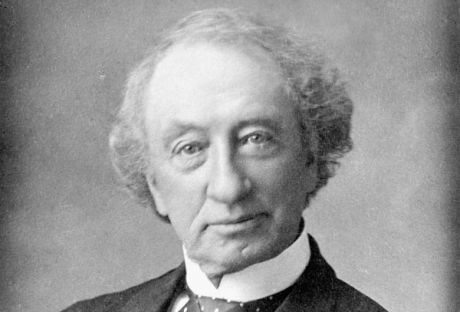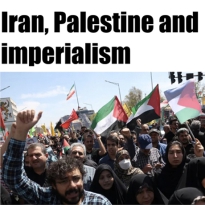Features
You are here
10 crimes of John A. Macdonald

January 11, 2015
Rather than a celebration of the “father of Confederation,” the 200th birthday of John A MacDonald on January 11 provides an opportunity to remember the history of Canada’s first Crime Minister—and the ongoing movements undoing his legacy.
On January 11 there will be state-sponsored glorifications of John A MacDonald across Canada, but also Indigenous-led teach-ins about his real legacy. Wilfred Laurier said that “the life of Sir John A MacDonald…is the history of Canada,” and it’s true: John A MacDonald shows us that Canada is built on colonialism and oppression, driven by capitalist expansion, and armed with state violence.
Obviously he was not singularly responsible for these policies, many of which began before or continued after him. But as Prime Minister for nearly two decades (1867-73 and 1878-91) he can’t avoid responsibility. His defenders, like biographer Richard Gwyn, claim that “to describe Macdonald as ‘a racist’ is pure, and smug, ‘presentism,’ or the judging of the past by the standards of the present.” But this assumes the past was universally reactionary and the present universally progressive—which ignores the resistance to his policies at the time, and ongoing movements against his continued legacy.
1. Founded Canada on stolen land
John A MacDonald is called the “father of Confederation” for signing the British North America Act of 1867 that created Canada. But this “accomplishment” created a colonial settler state built on the colonial oppression of Indigenous peoples, and the national oppression of the Québecois. Two years later MacDonald bought “Rupert’s Land,” nearly a quarter of the continent, from the Hudson’s Bay Company, without consultation of its population. As MacDonald admitted, “All these poor people know is that Canada has bought the country from the Hudson's Bay Company and that they are handed over like a flock of sheep to us.” But the history of Canada is also the history of resistance, from the 1869 and 1885 rebellions during MacDonald’s time, to Idle No More today.
2. Criminalized abortion
Canada imported British anti-abortion laws under MacDonald, who claimed that abortion “saps the very life blood of the nation.” This law lasted a century, sapping the very life of thousands of women. The law was liberalized in 1969 but it took a mass movement to defeat it in 1988, a movement that continues.
3. Criminalized homosexuality
Canada also imported British laws against homosexuality—which was punishable by death during MacDonald’s first two years in office. Though this was dropped the homophobic persecution continued. As his justice minister said in 1890, explaining an amendment to the Criminal Code,”The third section of the Bill contains a penalty for gross acts of immorality committed in reference to a male person…The maximum penalty of two years imprisonment is, I think, entirely inadequate.” The criminalization of homosexuality also lasted a century, and it was a mass movement—from Stonewall in the US, to protests against the Bathhouse raids in Toronto—that launched the gay liberation movement.
4. Used of starvation as a weapon
As a tactic of colonial expansion, MacDonald used starvation as a weapon against Indigenous peoples. As James Dascuk documented in Clearing the Plains: Politics, Starvation, and the Loss of Aboriginal Life, “For years, government officials withheld food from aboriginal people until they moved to their appointed reserves, forcing them to trade freedom for rations. Once on reserves, food placed in ration houses was withheld for so long that much of it rotted while the people it was intended to feed fell into a decades-long cycle of malnutrition, suppressed immunity and sickness from tuberculosis and other diseases. Thousands died.”
This tactic continues, as Mi’kmaq lawyer and activist Pamela Palmater explained: “Can you think of any Prime Minister, President or World Leader that would withhold food, water, or health care as a bullying tactic to force its citizens into compliance with a new government law, policy or scheme? Can you ever imagine this happening in Canada? I don't think most of us could.
Yet, this is exactly what is happening with Harper's implementation of the illegal C-27. Minister of Aboriginal Affairs Bernard Valcourt has threatened to cut off funds for food, water and health care if First Nations do not get in line and abide by this new legislation -- despite the fact that it was imposed without legal consultation and is now being legally challenged. How many First Nations children will have to die for Harper to sit down and work this out with First Nations?”
5. Created a repressive police
In response to the Red River Resistance of 1869, MacDonald sent a military force, saying “These impulsive half breeds have got spoilt by their émeute, and must be kept down by a strong hand until they are swamped by the influx of settlers.” MacDonald institutionalized this repressive force in 1873 with the creation of the North West Mounted Police—the precursor of the RCMP—that crushed the North West Rebellion of 1885. As Métis academic and activist Howard Adams wrote in his 1975 work Prison of Grass: Canada from a Native Point of View, “According to popular explanation, the Mounted Police force was established to prevent whiskey traders from buying Indian furs, which the Hudson’s Bay Company claimed as its exclusive right. However, it is not just a coincidence that the Mounted Police were established during the development of Indian reserves to ensure the ‘success’ of he treaty negotiations with the Indians and ‘help’ relocate Indians and halfbreeds to their reserves and colonies…The Indians, who had lived in the area for thousands of years without police, saw no reason for the establishment of a force in the Northwest since there was no serious disorder or lawlessness in the country. To the native people, this military force was similar to the federal troops who had invaded Fort Garry in 1870. The Mounties were not ambassadors of goodwill or uniformed men sent to protect Indians; they were the colonizer’s occupational forces and hence the oppressors of Indians and Métis.”
These policies continue—from the disregard for missing and murdered Indigenous women, to the criminalization of dissent. As Indigenous activist Clayton Thomas-Muller explained to APTN regarding the RCMP’s surveillance of him and others: “We are challenging the most powerful corporate entities on the planet. What we have on our side is endless human resources. We have the power of our ancestors and traditions fueling us. We are intimately aware of the domestic surveillance that is happening as well as the agenda to criminalize Indigenous dissent.”
6. Expanded capitalism
MacDonald is called a “nation builder” for extending the railroad across the country. But this was intertwined with waging war on the existing Indigenous nations—using the starvation to clear the path for the railroad, and using the railroad to transport the police to crush the 1885 rebellion. The expansion of the railroad itself killed hundreds of workers—primarily Chinese migrant workers—as part of expanding capitalist industry across the country. While the 1872 Toronto strike and the movement for the 9-hour workday pushed MacDonald to pass the Trade Union Act legalizing unions, he followed this with a law criminalizing picketing. Right from its inception, Canadian capitalism exploited workers and fuelled corruption—and MacDonald had to resign in 1873 when the Pacific Scandal exposed his receipt of campaign donations from the owner of the Canadian Pacific Railway. Today the nationalism of “nation building” is used to justify expanding tar sands pipelines across the country—which also undermine Indigenous sovereignty, waste resources on harmful work instead of good green jobs, and rely on complicity between corporations and their government regulators like the National Energy Board.
7. Promoted residential schools
Resuming his role as Prime Minister in 1878, MacDonald continued colonial oppression, expanding residential schools. As he said in 1879: “When the school is on the reserve, the child lives with its parents, who are savages, and though he may learn to read and write, his habits and training mode of thought are Indian. He is simply a savage who can read and write. It has been strongly impressed upon myself, as head of the Department, that Indian children should be withdrawn as much as possible from the parental influence, and the only way to do that would be to put them in central training industrial schools where they will acquire the habits and modes of thought of white men.” Residential schools were Canadian concentration camps, and included torture and medical experiments.
While Harper apologized for residential schools in 2008, his government has blocked the release of documents to the Truth and Reconciliation Commission, while continuing to remove Indigenous children from their communities through underfunding. According to Cindy Blackstock, member of the Gitksan Nation and executive director of the First Nations Child and Family Caring Society of Canada, “The number of First Nations children in care outside their homes today is three times the number of children in residential schools at the height of their operation.”
8. Outlawed the potlatch
Calling for “an iron hand on the shoulders” of Indigenous peoples, MacDonald outlawed the potlatch—because in his words, “It is not possible that Indians can acquire property or can become industrious with any good result while under the influence of this mania.” As the amendment to the Indian Act in 1884 stated, “Every Indian or other person who engages in or assists in celebrating the Indian festival known as the ‘Potlatch’ or in the Indian dance known as the ‘Tamanawas’ is guilty of a misdemeanor, and liable to imprisonment for a term of not more than six nor less than two months in any gaol or other place of confinement; and every Indian or persons who encourages… an Indian to get up such a festival… shall be liable to the same punishment.” But MacDonald failed to extinguish Indigenous traditions and ceremonies, as can be seen from ongoing Indigenous sovereignty movements.
9. Imposed a racist head tax
MacDonald extended his racism to anyone who did not represent “the Aryan race and Aryan principles.” In compensation for Chinese migrant workers dying to build the railway he’s credited with, MacDonald imposed a head tax and attacked their right to vote. As he said in 1885, “When the Chinaman comes here he intends to return to his own country; he does not bring his family with him; he is a stranger, a sojourner in a strange land, for his own purposes for a while; he has no common interest with us…has no British instincts or British feelings or aspirations, and therefore ought not to have a vote.” (While MacDonald was in office the vote was also denied to Indigenous people, women, people with disabilities, and men without property.) The migrant justice movement continues to challenge modern day head taxes—from the Temporary Foreign Workers Program, to the cuts to refugee health.
10. Executed dissidents
Not content with crushing the 1885 rebellion, MacDonald wanted to make an example of its leaders. He transferred the Métis leader Louis Riel from Winnipeg to Regina to ensure a white Anglophone jury, used the ancient British high treason law that carried the death penalty, and refused to consider a flood of petitions in support of Riel. As MacDonald said, “He shall hang, though every dog in Quebec shall bark in his favour.” MacDonald also incarcerated Cree Chief Poundmaker, and used a mass execution of Cree warriors as a public spectacle. As Daniel Paul, author of We Were Not the Savages, wrote, this was “the largest mass execution in Canadian history. The First Nations People abiding around the area, living in various states of starvation and malnutrition, were forced to watch the executions. The following is what the Father of Confederation had to say about it: 20th of November, 1885: In a letter to the commissioner of the Indian Affairs: ‘The executions of the Indians ought to convince the Red Man that the White Man governs.’”
January 11 is a day to remember Canada’s first Crime Minister, to celebrate the struggles that resisted his policies, and to keep building movements challenging his legacy.
This is republished from Rabble.ca
Section:










